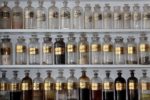It’s spring and advertisements for natural sunscreen are everywhere in Australia. This guide to choosing the best natural sunscreen in Australia will help you decide which one is best for you.
We, as consumers, are increasingly more concerned about the ingredients in the products we use, and how they affect our health. As a result, companies are marketing more products to meet that demand.
But with so many options available, how do you choose what is right for you and your family? How do you keep them safe from both the sun AND the effects of some of the ingredients used in sun care?
Here is an example of a natural sunscreen that may not be so natural. A recent entry into the sun protection market in Australia claims to be “all natural” and “safe for babies”. The only ingredients listed are Zinc Oxide and phenoxyethanol.
Phenoxyethanol is a preservative and known irritant. It is not a naturally occurring substance but a petrochemical byproduct.
While Australian authorities may consider it safe, Japan bans it. It is not recommended in Europe for use around the mouth and lips.
Like where you use sunscreen.
And what baby isn’t always putting parts of it’s body in its mouth?
So how do you see behind the greenwashing and make sure you make an informed choice?
Read on to learn how to choose natural sunscreen in Australia and become a label reading expert.
What is sunscreen?
We all know you use sunscreen to prevent the rays of the sun from burning your skin.
There are three types of ultraviolet radiation from the sun.
1. UVA – “aging” . These are longer rays which penetrate the deep layers of your skin. They cause damage, resulting in wrinkles and other signs of aging. UVA rays actually travel through glass. This picture shows how UVA rays damage your skin even through glass.
2. UVB – “burning” . These are shorter rays which affect the upper layers of your skin. They are responsible for sunburn. But it’s essential to our health for us to have some exposure to them. Our bodies make vitamin D in response to UVB rays,
3. UVC – The atmosphere of the earth blocks these rays so they don’t affect our skin.
What is SPF and how much is best?
Sun Protection Factor or SPF, measures how well your sunscreen protects you from UVB rays. The amount of sun exposure needed to burn your skin differs depending on the amount of melanin in your skin.
For example, if your unprotected skin takes 10 minutes to burn, an SPF 15 sunscreen will prevent burning 15 times longer (about 2.5 hours).
- SPF15 filters out 93 percent of incoming UVB rays,
- SPF 30 filters out 97 percent, and
- SPF 50 filters out 98 percent.
Or to put it another way, for every 100 rays that penetrate unprotected skin
- SPF15 only allows 7,
- SPF30 allows 3 and
- SPF50 only 2.
No sunscreen blocks all UV radiation from the sun, and you wouldn’t want it to. Remember your body needs UVB to produce vitamin D essential for health.
The telltale reddening/burning of your skin is a reaction to UVB rays and does not show possible UVA damage. In fact it can take up to 24 hours for your skin to develop the red ‘burn’ fully.
How is SPF Tested?
In Australia, SPF testing is per the requirements of the AS/NZS 2604:2012 quality standard.
Ten human volunteers with Fitzpatrick Skin Type of 3 have product applied at a thickness of 2mg per square centimetre of skin. Then artificial ultraviolet light is shone on the skin and they time how long the skin takes to burn.
The Fitzpatrick scale classifies your skin type according it’s pigment amount and your skin’s reaction to sun exposure. You can find out your Fitzpatrick Skin Type with this simple quiz.
How does sunscreen protect your skin?
There are two types of ingredients in sunscreen that protect your skin from the damaging rays of the sun. Physical and chemical.
Physical sunscreens use minerals such as zinc oxide and titanium oxide. These create a layer on your skin to reflect and block the sun’s rays.
Chemical sunscreens absorb the sun’s rays so they don’t penetrate deeply into your skin.
What is broad-spectrum sunscreen?
In the past, sunscreens only protected against UVB rays. That is why SPF is only a measure of UVB protection.
‘Broad’ or ‘Full’ spectrum sunscreens protect your skin from UVA rays as well.
Zinc Oxide and Titanium Oxide both protect from UVB rays. Only Zinc also provides UVA protection.
A Titanium dioxide based formula needs other ingredients to provide broad-spectrum coverage.
Some Titanium Oxide based sunscreens market themselves as natural and mineral. But in fact they include chemicals to provide the UVA protection.
How do I know if my natural sunscreen is safe and effective?
Studies show overexposure to ultraviolet radiation can cause skin cancer. Because of this, Australia regulates sunscreen like it does medicine.
The government organisation responsible is the Therapeutic Goods Administration (TGA). Products claiming to be sunscreen, have SPF over 15 or be water resistant need TGA approval.
The active ingredients used in sunscreen need to be approved and the sunscreen has to be made in approved facilities.
At time of writing there are 30 ingredients approved for sunscreens in Australia. Only two of them are mineral – Zinc Oxide and Titanium Oxide. The rest are chemical.
Many ingredients used in chemical sunscreens have been linked to health and environment issues such as hormone disruption or coral reef bleaching. And some, like phenoxyethanol, are known as irritants and considered unsafe outside of Australia.
Lastly, tests of some popular sunscreens in Australia and New Zealand show several fail to meet their SPF claims, despite approval.
What are secondary sunscreens?
Secondary sunscreens offer some sun protection but have another purpose. Secondary sunscreens considered cosmetics instead of medicines. Cosmetics must list ALL their ingredients and must be both safe and effective.
Because they don’t fall under TGA regulations, secondary sunscreens cannot
- use the word sunscreen,
- claim a SPF higher than 15 (whether tests show higher or not)
- claim to be water proof or water resistant
There are several natural and organic secondary sunscreens available in Australia. Without synthetic ingredients, they are safer for babies and those with sensitive skins. Our Organic Sun is a SPF15 moisturiser using non-nano uncoated zinc as the active ingredient.
What is natural?
In Australia the word natural in advertising is not regulated. You can find it on all sorts of products containing petrochemicals.
But ACCC took action against Gaia Skin Naturals for “misleading” use of the term organic on some of their baby products.
Gaia described the products as pure, natural and organic, but they contain two synthetic chemical preservatives.
The TGA recently released guidelines on using the term “natural” in advertising to the public. Claims must not be misleading and must be truthful, valid, accurate and substantiated.
What about preservatives in natural sunscreen?
Sunscreens and beauty products use preservatives to prevent microbial growth and ensure your safety. Products that are not well preserved can cause skin and eye infections.
There has been a backlash against preservatives over the past few years. Why? Parabens, a common type of petrochemical preservative, can penetrate the skin.
A 2004 study found evidence of parabens in the breast tissue of over 95% of the women studied. They’ve also been found in the bodies of marine animals. Parabens may cause hormone disruption and reproductive issues.
So people now want natural products with no preservatives. But are they safe?
If the product claims to not include preservative, check to see if it has any water or liquid ingredients. Formulations made with no water, like balms, do not need preservatives.
But you make lotions and creams by emulsifying oil with water. And water is a breeding ground for mould, fungus, bacteria and yeast.
Some safe natural preservatives used in Australia are:
- Leucidal, (Leuconostoc/Radish Root Ferment Filtrate)
- Naticide – an organic vegetable-based fragrance approved as a preservative in organic skin care by the ACO. (Note: Naticide is often listed as the INCI name “parfum” or “fragrance” and is not the same as synthetic fragrance. If you’re unsure, call the manuacturer to ask).
- Suprapein – a natural preservative made from herbs and spices
However some products claim to be preserved by other natural means that aren’t preservatives.
And remember, if a product has TGA approval, then it doesn’t need to list all ingredients. So even if there are none listed, it could still include petro-chemical preservatives. Or ingredients you already know you’re allergic to.
How to choose the safest natural sunscreen?
The best thing to protect your family from UV radiation is to adopt sun safe practices.
Limit exposure to damaging UV rays by:
- covering up with lightweight clothing and hat,
- keeping out of the sun in the heat of the day,
- applying sun protection to the body not covered by clothing,
- ensuring you apply sun protection at least 20 minutes before sun exposure.
But choosing the best natural sunscreen to care for your family is a personal decision. There is all the information above. But you also need to take into account your budget, convenience and personal ethics. Not to mention any allergies or skin sensitivities.
Which is why I’ve created a handy reference guide as a short cut for the information in this blog post. The Green Foot Mama Natural Sunscreen Cheatsheet also includes my 6 tips for choosing the best natural sunscreen product for your family. Enjoy!




